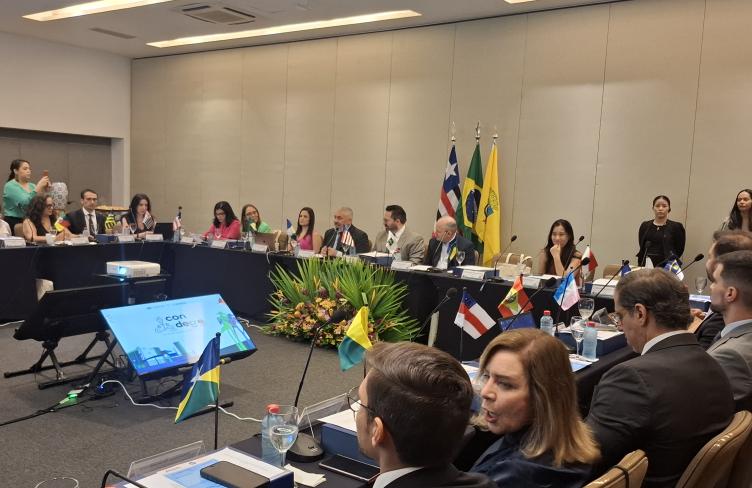
In a first dialogue, the Association for the Prevention of Torture (APT) has brought together stakeholders from across the justice sector in Mato Grosso, Brazil, to discuss ways to strengthen torture prevention through custody hearings.
In partnership with the Mato Grosso Court of Justice (TJMT) and with the support of the Making Justice of the State Programme (CNJ/UNDP), the APT’s online workshop included magistrates, experts, psychologists and social workers who act in custody hearings.
A total of 58 participants took part in the workshop – "Confronting torture in custody hearings: practical aspects for prevention, identification and documentation" – which was held in partnership with the School of Magistrature of the Court of Mato Grosso.
“It is the first time we have brought together such a multidisciplinary group in support of torture prevention,” Sylvia Dias, APT’s Senior Legal Adviser in Brazil, said.
President of the Inter-American Commission on Human Rights, Joel Hernández García, was invited to provide the opening address.
"Generally, as President of the Inter-American Commission on Human Rights, I address many actors in government, in the executive branch, in the Ministry of Foreign Affairs, but we rarely have this opportunity to address the operators of justice – in this case, judges,” H.E Mr Hernández said.
“You are the people who are able to apply the law, which is in your hands. You have the guardianship, the custody, of human rights.”
During the workshop, participants discussed ways to document torture reports in custody hearings, the importance of post-hearing referrals and the need to strengthen inter-institutional dialogue in order to establish clear and practical protocols, including for the preparation of corpus delicti reports.
The discussion also highlighted the fundamental role that magistrates can play to confront torture, given the culture of violence that still prevails in Brazilian society, and that the judicial authorities should be familiar with different techniques for gathering information from detainees, taking into account the vulnerabilities of their situation.
Specific questions were also raised in regard to the gender dimensions of torture and ill-treatment, including the types of physical, psychological and sexual violence that women and people who identify as LGBTQI+ can face, and the forms of evidence that can be collected.
This short video presents some of the key themes from the workshop.
Launch of the Torture Prevention Manual at Custody Hearings
A new manual has been prepared that will support judges in Brazil to identify and respond to incidents of torture and ill-treatment through custody hearings they conduct.
The Manual for the Prevention of Torture and Maltreatment for Custody Hearings was developed as part of a Technical Cooperation Agreement between APT and Brazil’s National Justice Council, with support from the United Nations Office on Drugs and Crime (UNODC).
The Manual focuses on custody hearings as a critical moment for detecting physical and psychological violence that may have occurred from the initial contact with the police to the person’s arrival in the courtroom, including their time in police vehicles and in detention.
It proposes practical guidelines, drawn from observing custody hearings, and also identifies promising practices to guide judges and others in the criminal justice system to collect evidence of torture and ill-treatment.
For example, the Manual emphasises the important role that judges can play to create an open and accessible courtroom, including by speaking with detainees in language they understand.
In addition, at the start of the hearing, the judge should explain that one of the objectives of the hearing is to identify whether any kind of torture or ill-treatment has taken place since the time the person was detained.
Further, the magistrate should inquire whether the detainee has been afforded due process guarantees, such as contact with their family, access to a lawyer, medical attention and been informed of his or her rights, including the right to silence.
The Manual also provides a series of questions that the judge can ask to not only verify whether or not torture or ill-treatment has occurred, but how it has occurred, where, when, why and all the relevant facts related to the incident.
In the preface to the Manual, Barbara Bernath, APT Secretary General, and Juan Mendez, former UN Special Rapporteur on Torture and current member of the APT Governing Council, noted that, after a visit to Brazil some 20 years ago, the then UN Special Rapporteur on Torture forcefully called on the judicial authorities to be just as concerned about the rights of detainees as they were about the need to repress crime.
“We believe that this publication will promote changes, both in mindset and in practice, that will contribute to the Brazilian judiciary's progress along this path. And we reaffirm here our commitment to work with all those in the justice system to this end,” Ms Bernath and Mr Mendez wrote.
Watch the launch of the Manual:https://www.youtube.com/watch?v=XRqP1nOKXuY
Download the Manual: https://www.cnj.jus.br/wp-content/uploads/2020/11/manual_de_tortura-web.pdf


